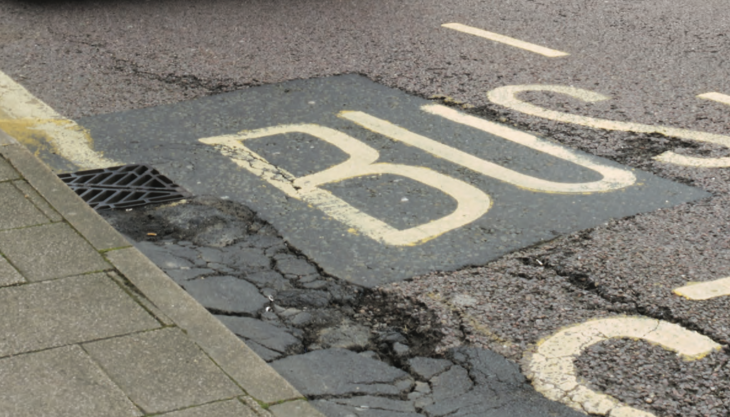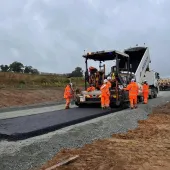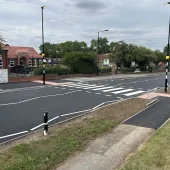25 years of ALARM and still no silver lining

Chancellor’s £2.5 billion pothole pledge not enough to improve local roads, says AIA
THE findings of this year’s Annual Local Authority Road Maintenance (ALARM) survey indicate that, while a step in the right direction, the Chancellor’s additional £2.5 billion pothole pledge is not enough to plug the gap in local road maintenance budgets, let alone the rising backlog of repairs.
Now in its 25th year, the ALARM survey, published today [March 24] by the Asphalt Industry Alliance (AIA), shows that the green shoots of improving conditions reported in 2019 have not been sustained, with local authorities having to cope with an average drop in overall highway maintenance budgets of 16%.
Moreover, with overall local authority spending down, highway teams have been allocated a smaller slice of a smaller cake to maintain the road surface and structure, which has led to a widening funding gap in the amount needed to maintain the carriageway to target conditions.
ALARM 2020 reports that this shortfall is now an average of £4.9 million (£5.4 million in England) for local authorities across England, London and Wales, up from £3.9 million last year.
Less funding for the carriageway inevitably means less maintenance, and this is borne out by ALARM 2020’s reported reduction in pothole repairs, downward target adjustments and declining structural road conditions.
This year there are 7,240 fewer miles of roads reported to be in ‘Good’ structural condition, with 15 years or more of life remaining, and 1,100 more miles of roads classed as ‘Poor’, with less than five years’ life remaining, bringing the total in this category to 42,675 miles. Meanwhile, in the middle, there is a continued increase in the number classed as ‘Adequate’, with between five and 15 years’ life remaining, suggesting an ongoing slide towards mediocrity.
Rick Green, chair of the AIA, said: ‘Highway maintenance budgets have dropped back to where they were two years ago. Over the past 25 years we have repeatedly seen this pattern of short-term cash injections to stem accelerating decline, only to be followed by further years of underfunding.
‘This stop-start approach has been wasteful and does nothing to improve the condition of local road network on which we all rely. In fact, it has just contributed to a rising bill to put things right.
‘The £2.5 billion extra funding over the next five years announced in the Budget will certainly be welcomed by hard-pressed local authority highway teams dealing with increasing demands on smaller budgets, as well as the effects of extreme weather events, such as the recent storms, on an ageing network.
‘However, £500 million extra a year divided across English local authorities is a long way off the one-time catch-up cost of £11.14 billion that ALARM 2020 indicates is needed to bring our local roads across England, London and Wales up to a level from which they can be maintained cost-effectively going forward.
‘What’s needed is additional and sustained investment to help underpin the Government’s levelling-up strategy and social cohesion goals, as well as complement its ambitions for more sustainable modes of transport.
‘Twenty-five years on and we are dealing with new and unprecedented challenges, and understandably resources will need to be prioritized accordingly in the short term. Looking ahead, however, a sustainably funded, well-maintained local road network will be key to supporting recovery and regrowth.’
Steve Spender, chief executive of the Institute of Highway Engineers, said: ‘The IHE continues to support the AIA, which through the publication of the ALARM survey over the last 25 years has provided a good annual barometer of the true condition of our local highway networks.
‘Once again, this year’s report provides a clear indication that there is a need for an increase, in real terms, of the funding necessary to bring the network back to a suitable standard.
‘With average highway maintenance budgets down by approximately 16% and the estimated cost for getting our roads back to reasonable state of more than £11 billion, this can only create a situation where reactive repairs are the chosen option rather than the necessary proactive planned approach.
‘Whilst welcoming the recent budget announcement of an additional £2.5 billion over the next five years, this only equates to £500 million across the English authorities, which falls well short of what, in real terms, is required to protect our networks for the future.
‘The financial pressure on local authorities continues to be a challenge, particularly following the effects of the recent severe weather and damage caused by the extensive flooding, which will result in an inevitable increase in the pressure on already stretched highway budgets.’
Paul Fleetham, managing director of Tarmac Contracting, commented: ‘It’s only right that managing the impact of COVID-19 remains the nation’s top priority and immediate focus, however the socio-economic importance of having a high-quality, well-maintained local road network should not be underestimated.
‘Local roads remain the lifeblood of our economy and on their own represent an asset worth more than £400 billion. Despite making up 97% of the UK’s roads, the ALARM survey has once again highlighted that significant parts of the network are below acceptable standards due to years of underinvestment – it’s important that this imbalance is redressed.
‘The Government’s recently announced £2.5 billion pothole pledge is undoubtedly a positive step in the right direction. After many years of false starts, highways contractors are primed, ready and well-resourced with the capacity to deliver comprehensive preventative and structural maintenance programmes. Local authorities now need to see longer-term commitments and sustained periods of investment to ensure that our road networks are no longer treated as a second-class asset.’
ALARM survey 2020 key facts:
- Average highway maintenance budgets down 16% – to £20.7 million per authority (2018/19: £24.5 million).
- Local authorities reported that, on average, 50% of the annual highway maintenance budget is spent on the carriageway (55% in 2019).
- Disparity of funding – ranging from less than £1,300 per mile of local authority road network to more than £51,000 per mile.
- £826.6 million – annual carriageway maintenance budget shortfall (£5.4 million per authority in England; £3.6 million in London and £4.2 million in Wales).
- £11.14 billion – estimated one-time catch-up cost to get roads back into a reasonable, steady state, up from £9.79 billion reported in 2019 (£85.4 million per authority in England; £24.3 million in London and £32.8 million in Wales).
- 11 years – estimated time it would take to clear the maintenance backlog if local authorities had the funding and resources available to do the work.
- 66 years – average time before a road is resurfaced (76 years in England; 36 years in London and 58 years in Wales).
- A pothole is filled every 21 seconds in England and Wales.
- £22.8 million – total cost of dealing with compensation claims, including £8.1 million paid out in compensation.
A copy of the ALARM survey 2020 can be downloaded below.









